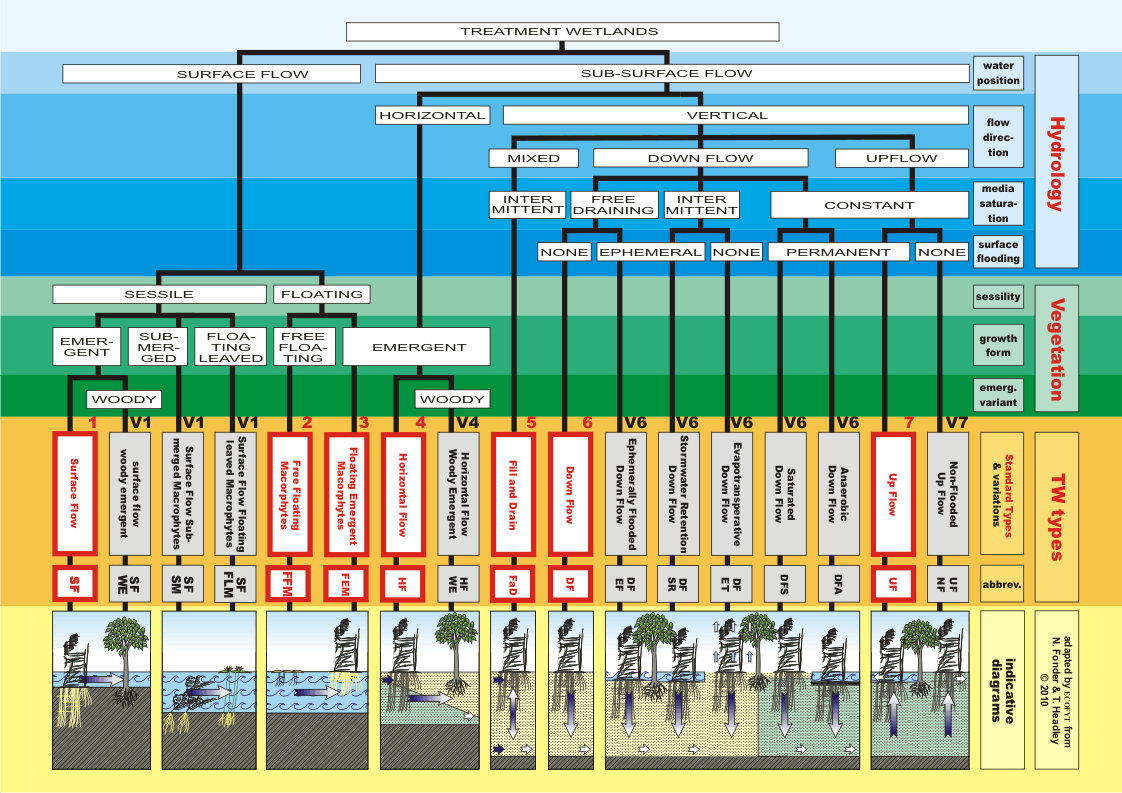Operation
There is so much to tell about how helophyte filters work...

Something about the operation of Constructed Wetlands
First about the picture above: If you want to go deeper into the matter you can refine it further and further. Dr. Nathalie Fonder (Belgium) and Dr. Tom Headley (Australia) developed it into a very nice scheme in which the way of flow, the degree of water saturation and the type of planting are decisive. Also because ECOFYT was a bit involved in the discussion around it, we like to share the schedule on our site. And if you control this picture, you will see that there are just 17 different types. It is our task to make the best choice for each project.
The effect of the constructed wetlands is mainly based on the activities of bacteria in the soil. Especially around the reed roots, large concentrations of bacteria develop after a short time, which break down the waste products in the water very efficiently. The bacterial growth around the roots is stimulated by the reed plants themselves, which absorb oxygen from the air as a kind of "snorkel" and transport it to the roots.
A little further away from the roots, the soil is low in oxygen (anaerobic) and there are other bacteria that do not need oxygen. It is precisely this unique combination of different types of bacteria in a reed filter that provide the great purifying power.
In addition to this role of the plants, they also ensure that the system does not clog up, due to the continuity of growth and death of the roots.
To a certain extent, the plants also live on the phosphate and nitrogen in the wastewater, but a considerable part of this is released when the above-ground parts of the plants die off in winter. The main reason for the efficiency of constructed wetlands therefore remains because of the bacterial activities.
Nitrogen and phosphate
Of all small systems, constructed wetlands are best able to remove phosphates and nitrogen from wastewater.
Complex nitrogen compounds such as proteins, but also ammonium are broken down and partly converted into nitrates and N2, the (harmless) nitrogen in our atmosphere.
Phosphates are bound in the filter. Because this material is recorded in the system, we are dealing with a finite process; in the long run, the filter will be saturated and unable to absorb more phosphate. In our calculations we usually assume a storage capacity for about 25 years. After this period, if necessary, the top layer of the system can be renewed by replacing the soil. The soil saturated with phosphate is good to use as fertilizer.
It is therefore important to define the life of a constructed wetland, especially the substances that are bound. Most of the other processes are conversion processes by the aforementioned bacteria. They continue as usual, even after those 25 years.
Summarized
- So it is the bacteria in the soil that do the actual purifying work.
- The reed plants mainly serve for the oxygen supply.
- They also deserve the credit for the enormous numbers of bacteria in the soil.
- In addition, the roots of the reed ensure that the soil does not become clogged.
- Bacteria convert complex nitrogen compounds into nitrate and even into N2, the harmless air nitrogen.
- Additives such as lime and iron bind the phosphate.
- The reed plants also absorb phosphates and nitrogen to a limited extent for growth.


